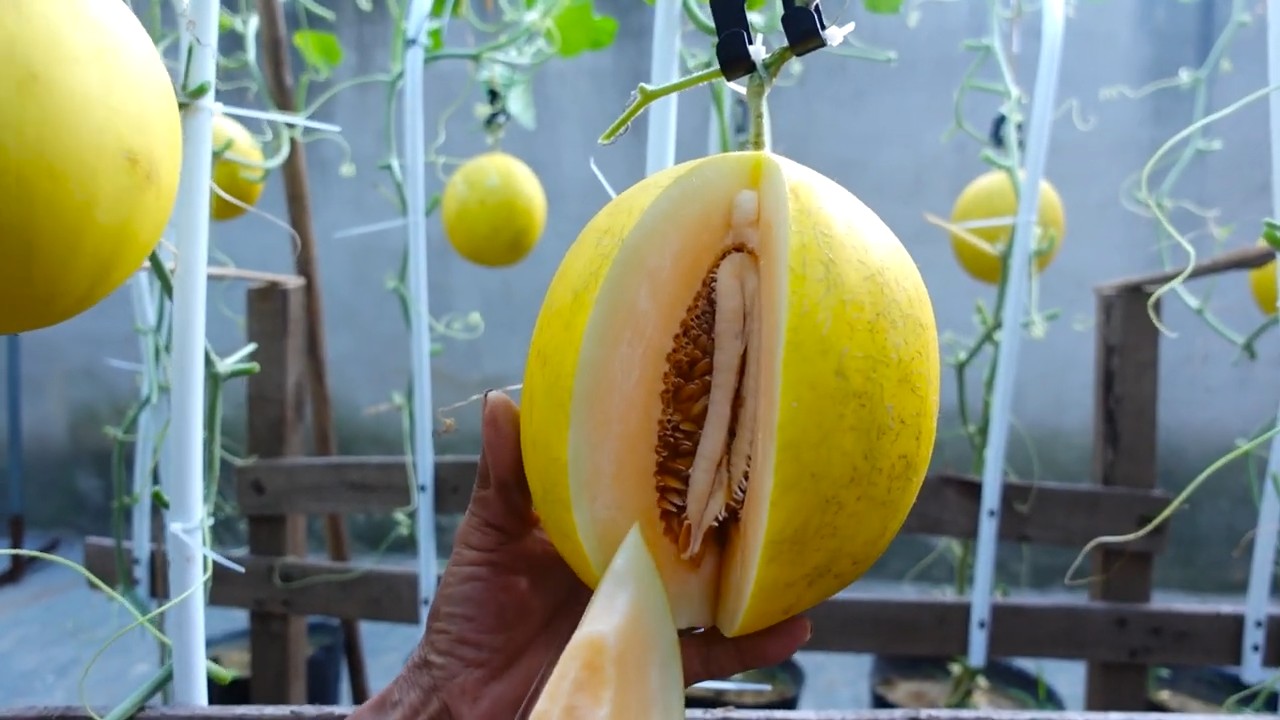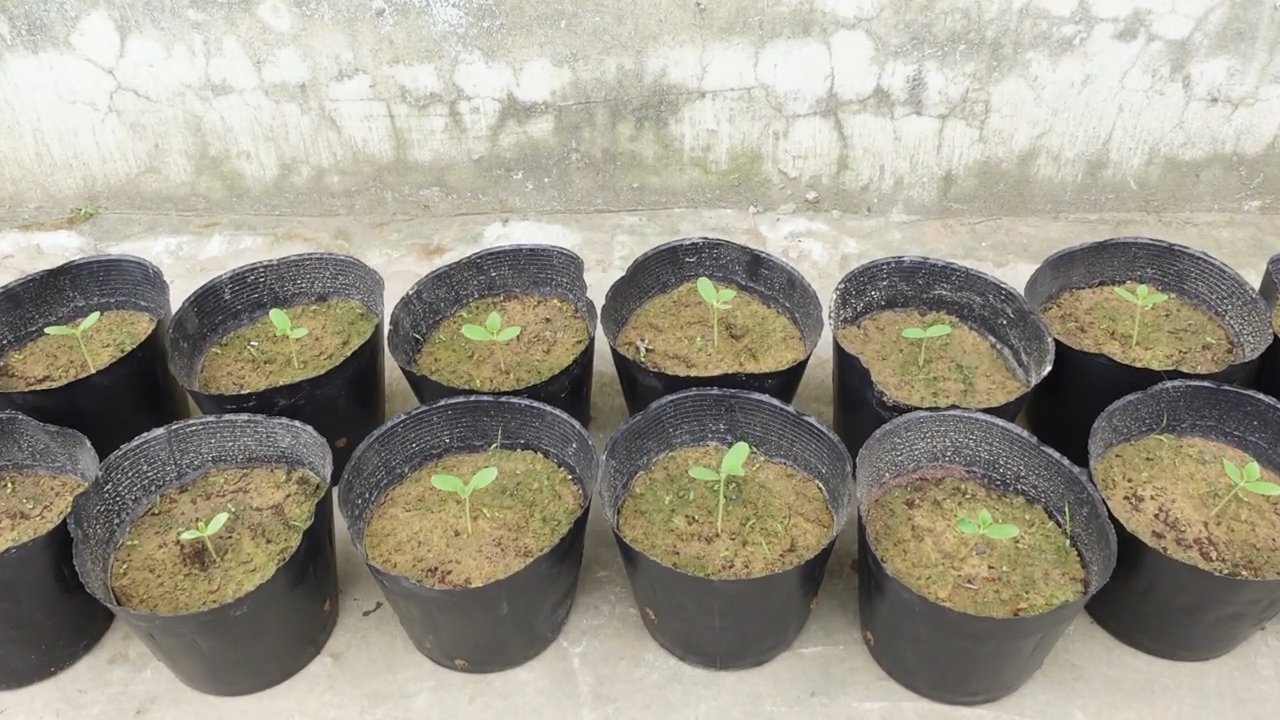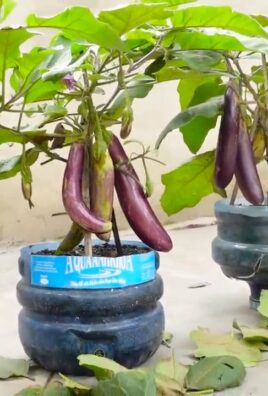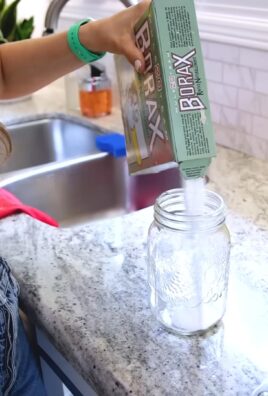Sweet cantaloupe high yield – that’s the dream, isn’t it? Imagine biting into a perfectly ripe, juicy cantaloupe, bursting with flavor, all grown right in your own backyard! Forget those bland, store-bought melons; we’re talking about a homegrown taste sensation. But let’s be honest, achieving a sweet cantaloupe high yield can feel like a daunting task.
For centuries, cantaloupe has been a symbol of summer abundance, enjoyed by cultures around the globe. From ancient Egypt to modern-day picnics, this melon has always held a special place on our tables. But getting a truly impressive harvest? That’s where the DIY magic comes in!
Let’s face it, gardening can be tricky. Pests, diseases, and unpredictable weather can all conspire to ruin your chances of a bountiful harvest. That’s why I’m so excited to share these simple yet effective DIY tricks and hacks that will help you maximize your cantaloupe production. I’ve learned these over years of trial and error, and I’m confident they’ll make a huge difference in your garden. Whether you’re a seasoned gardener or just starting out, these tips will empower you to grow the sweetest, most abundant cantaloupes you’ve ever tasted. Get ready to roll up your sleeves and transform your garden into a cantaloupe paradise!

DIY: Süße Cantaloupe-Melonen mit Höchstertrag – Mein Geheimrezept!
Hallo liebe Gartenfreunde! Ich liebe Cantaloupe-Melonen, und nichts ist besser, als eine saftige, süße Melone aus dem eigenen Garten zu ernten. Über die Jahre habe ich einige Tricks und Kniffe gelernt, um den Ertrag und die Süße meiner Cantaloupe-Melonen zu maximieren. In diesem Artikel teile ich mein bewährtes DIY-Rezept für Cantaloupe-Melonen mit Höchstertrag mit euch. Keine Angst, es ist einfacher als es klingt!
Was du brauchst:
* Cantaloupe-Melonen Samen (am besten eine Sorte, die für dein Klima geeignet ist)
* Anzuchttöpfe oder Eierkartons
* Anzuchterde
* Gartenerde (gut durchlässig und nährstoffreich)
* Kompost oder gut verrotteter Mist
* Mulch (Stroh, Holzhackschnitzel oder Grasschnitt)
* Gartenvlies (optional, für den frühen Start)
* Gießkanne oder Gartenschlauch
* Gartenschere
* Dünger (speziell für Melonen oder Gemüse)
* Pflanzstäbe oder Rankgitter (optional, je nach Sorte)
* Geduld und Liebe!
Vorbereitung ist alles: Der Start in die Saison
Der Schlüssel zu einem erfolgreichen Cantaloupe-Anbau liegt in der Vorbereitung. Ich beginne meistens schon im Haus, um den Melonen einen Vorsprung zu verschaffen.
1. Samen vorziehen:
* Wann beginnen? Beginne etwa 4-6 Wochen vor dem letzten erwarteten Frosttermin in deiner Region mit der Anzucht. Das gibt den kleinen Pflänzchen genug Zeit, um stark zu werden, bevor sie ins Freie kommen.
* Die richtige Erde: Fülle deine Anzuchttöpfe oder Eierkartons mit Anzuchterde. Diese ist nährstoffarm und locker, ideal für die Keimung.
* Samen säen: Lege 2-3 Samen pro Topf etwa 1-2 cm tief in die Erde.
* Feuchtigkeit ist wichtig: Gieße die Erde vorsichtig an, sodass sie feucht, aber nicht nass ist.
* Der richtige Standort: Stelle die Töpfe an einen warmen, hellen Ort. Eine Fensterbank mit Südausrichtung ist perfekt. Du kannst auch eine Pflanzenlampe verwenden, wenn du nicht genügend natürliches Licht hast.
* Warm halten: Cantaloupe-Samen keimen am besten bei einer Temperatur von 21-27°C. Eine Heizmatte unter den Töpfen kann helfen, die Temperatur konstant zu halten.
* Geduld haben: Die Keimung dauert in der Regel 7-14 Tage. Halte die Erde feucht, aber vermeide Staunässe.
2. Den Boden vorbereiten:
* Der richtige Standort: Cantaloupe-Melonen lieben die Sonne! Wähle einen Standort, der mindestens 6-8 Stunden direkte Sonneneinstrahlung pro Tag erhält.
* Bodenbeschaffenheit: Der Boden sollte gut durchlässig und nährstoffreich sein. Cantaloupe-Melonen mögen keine “nassen Füße”.
* Bodenverbesserung: Grabe den Boden um und mische reichlich Kompost oder gut verrotteten Mist unter. Das verbessert die Bodenstruktur und versorgt die Pflanzen mit wichtigen Nährstoffen.
* pH-Wert: Der ideale pH-Wert für Cantaloupe-Melonen liegt zwischen 6,0 und 6,8. Du kannst den pH-Wert mit einem Bodentest überprüfen und gegebenenfalls anpassen.
Der Umzug ins Freie: Auspflanzen und Pflegen
Sobald die Frostgefahr vorüber ist und die kleinen Melonenpflanzen stark genug sind (etwa 10-15 cm hoch), können sie ins Freie umziehen.
3. Auspflanzen:
* Abhärten: Bevor du die Pflanzen ins Freie setzt, solltest du sie abhärten. Stelle sie dazu für einige Tage tagsüber ins Freie und hole sie nachts wieder herein. Das hilft ihnen, sich an die neuen Bedingungen zu gewöhnen.
* Der richtige Zeitpunkt: Pflanze die Melonen an einem bewölkten Tag oder am späten Nachmittag aus, um sie vor der prallen Sonne zu schützen.
* Pflanzabstand: Halte einen Pflanzabstand von etwa 60-90 cm zwischen den Pflanzen und 120-150 cm zwischen den Reihen ein. Cantaloupe-Melonen brauchen Platz zum Wachsen!
* Pflanzlöcher: Grabe Pflanzlöcher, die etwas größer sind als die Wurzelballen der Pflanzen.
* Vorsichtig sein: Nimm die Pflanzen vorsichtig aus den Anzuchttöpfen und setze sie in die Pflanzlöcher. Achte darauf, die Wurzeln nicht zu beschädigen.
* Angießen: Gieße die Pflanzen nach dem Auspflanzen gründlich an.
4. Die richtige Pflege:
* Gießen: Cantaloupe-Melonen brauchen regelmäßig Wasser, besonders während der Fruchtbildung. Gieße am besten früh am Morgen, damit die Blätter Zeit haben, abzutrocknen, bevor die Sonne aufgeht. Vermeide es, die Blätter direkt zu gießen, da dies Pilzkrankheiten fördern kann.
* Mulchen: Bringe eine Schicht Mulch (Stroh, Holzhackschnitzel oder Grasschnitt) um die Pflanzen herum aus. Das hilft, die Feuchtigkeit im Boden zu halten, Unkraut zu unterdrücken und den Boden kühl zu halten.
* Düngen: Dünge die Melonen regelmäßig mit einem speziellen Melonendünger oder einem Gemüsedünger. Befolge die Anweisungen auf der Verpackung. Ich dünge meine Melonen alle 2-3 Wochen.
* Rankhilfe: Je nach Sorte können Cantaloupe-Melonen sehr lange Ranken bilden. Du kannst ihnen eine Rankhilfe (Pflanzstäbe oder Rankgitter) anbieten, um Platz zu sparen und die Früchte vor dem Bodenkontakt zu schützen.
* Schädlinge und Krankheiten: Achte auf Schädlinge wie Blattläuse, Schnecken und Gurkenkäfer. Kontrolliere die Pflanzen regelmäßig und bekämpfe Schädlinge bei Bedarf mit natürlichen Mitteln. Pilzkrankheiten wie Mehltau können ebenfalls auftreten. Sorge für eine gute Belüftung und vermeide es, die Blätter zu gießen.
Der Trick für süße Melonen:
Hier kommt mein Geheimnis für besonders süße Cantaloupe-Melonen:
* Weniger ist mehr: Beschränke die Anzahl der Früchte pro Pflanze. Entferne überzählige Blüten oder kleine Früchte, damit die Pflanze ihre Energie auf die verbleibenden Früchte konzentrieren kann. Ich lasse in der Regel 3-4 Früchte pro Pflanze reifen.
* Wassersparen: Reduziere die Wassergabe, sobald die Früchte anfangen zu reifen. Das zwingt die Pflanze, Zucker in die Früchte einzulagern, was sie süßer macht. Aber Achtung: Die Pflanzen dürfen nicht komplett austrocknen!
* Sonnenbaden: Drehe die Melonen regelmäßig, damit sie von allen Seiten Sonne abbekommen. Das fördert die gleichmäßige Reifung und Süße.
Die Ernte: Der Lohn der Mühe
Die Ernte ist der aufregendste Teil! Aber wann sind Cantaloupe-Melonen reif?
5. Reife erkennen:
* Der Duft: Reife Cantaloupe-Melonen verströmen einen süßen, aromatischen Duft.
* Die Farbe: Die Schale der Melone verändert ihre Farbe von grünlich zu einem gelblichen oder beigen Ton.
* Der Stiel: Der Stielansatz der reifen Melone löst sich leicht vom Stiel. Wenn du leicht daran ziehst und er sich löst, ist die Melone reif.
* Der Klang: Klopfe leicht auf die Melone. Eine reife Melone klingt hohl.
6. Ernten:
* Vorsichtig sein: Schneide die Melone vorsichtig mit einer Gartenschere vom Stiel ab.
* Genießen: Lass dir die frisch geerntete Cantaloupe-Melone schmecken! Sie ist am besten, wenn sie gekühlt ist.
Zusätzliche Tipps für den Erfolg:
* Sortenwahl: Wähle eine

Conclusion
So, there you have it! Cultivating a sweet cantaloupe high yield in your own garden is not just a dream; it’s an achievable reality with this simple yet effective DIY trick. We’ve walked you through the process, highlighting how this method can significantly boost your harvest and enhance the natural sweetness of your cantaloupes. Forget store-bought melons that often lack flavor and freshness. Imagine biting into a juicy, intensely sweet cantaloupe that you nurtured from seed to fruit, knowing exactly what went into its growth.
This isn’t just about growing cantaloupes; it’s about connecting with nature, understanding the nuances of plant care, and reaping the rewards of your hard work. The satisfaction of harvesting your own produce is unparalleled, and when that produce is as delicious as a homegrown, perfectly ripened cantaloupe, it’s a truly special experience.
But the beauty of gardening lies in its adaptability. Feel free to experiment with variations of this DIY trick. For instance, if you live in a particularly humid climate, consider adding a layer of mulch around the base of the plants to improve drainage and prevent fungal diseases. You could also try different types of organic fertilizers to see which one yields the best results for your specific soil conditions. Some gardeners have found success by incorporating companion planting, such as planting basil or marigolds near their cantaloupes to deter pests. Don’t be afraid to get creative and tailor the method to suit your unique gardening environment.
The key takeaway is that achieving a sweet cantaloupe high yield is within your reach. This DIY trick provides a solid foundation, but your own observations and adjustments will ultimately determine your success. We encourage you to embrace the learning process, document your progress, and share your findings with fellow gardeners.
Now, it’s your turn! Grab your gardening gloves, prepare your soil, and put this DIY trick to the test. We’re confident that you’ll be amazed by the results. And most importantly, don’t forget to share your experiences with us! We’d love to hear about your successes, challenges, and any modifications you made along the way. Your insights could help other gardeners achieve their own cantaloupe-growing dreams. Share your photos, tips, and stories in the comments section below. Let’s build a community of cantaloupe enthusiasts and learn from each other’s experiences. Happy gardening!
Frequently Asked Questions (FAQ)
Q: What type of soil is best for growing cantaloupes?
A: Cantaloupes thrive in well-drained, sandy loam soil that is rich in organic matter. The soil should have a pH level between 6.0 and 6.8. Before planting, amend the soil with compost or well-rotted manure to improve its fertility and drainage. Avoid heavy clay soils, as they can retain too much moisture and lead to root rot. If you have clay soil, consider growing cantaloupes in raised beds or containers.
Q: How much sunlight do cantaloupes need?
A: Cantaloupes require at least 6-8 hours of direct sunlight per day to produce sweet and flavorful fruit. Choose a planting location that receives ample sunlight throughout the day. If you live in a particularly hot climate, some afternoon shade may be beneficial to prevent the plants from overheating.
Q: How often should I water my cantaloupe plants?
A: Cantaloupe plants need consistent moisture, especially during fruit development. Water deeply and regularly, aiming to keep the soil consistently moist but not waterlogged. Avoid overhead watering, as it can promote fungal diseases. Instead, use a soaker hose or drip irrigation system to deliver water directly to the roots. Reduce watering as the fruits begin to ripen to concentrate the sugars and enhance their sweetness.
Q: What are some common pests and diseases that affect cantaloupes?
A: Common pests that can affect cantaloupes include aphids, squash bugs, cucumber beetles, and vine borers. Diseases include powdery mildew, downy mildew, and fusarium wilt. Regularly inspect your plants for signs of pests or diseases and take appropriate action. Organic pest control methods, such as insecticidal soap or neem oil, can be effective for controlling many pests. For diseases, ensure good air circulation, avoid overhead watering, and consider using a fungicide if necessary. Crop rotation can also help prevent soilborne diseases.
Q: When is the best time to harvest cantaloupes?
A: Cantaloupes are typically ready to harvest when they slip easily from the vine with a gentle tug. The skin will also change color from green to a tan or yellowish hue, and the melon will have a fragrant aroma. Avoid pulling the melon from the vine, as this can damage the fruit. Once harvested, cantaloupes can be stored in the refrigerator for up to a week.
Q: Can I grow cantaloupes in containers?
A: Yes, you can grow cantaloupes in containers, but you’ll need to choose a large container (at least 20 gallons) to accommodate the plant’s root system. Use a well-draining potting mix and provide adequate support for the vines. Container-grown cantaloupes may require more frequent watering and fertilization than those grown in the ground. Choose a compact or bush variety of cantaloupe for container gardening.
Q: What type of fertilizer should I use for cantaloupes?
A: Cantaloupes benefit from regular fertilization throughout the growing season. Use a balanced fertilizer (e.g., 10-10-10) at planting time, and then switch to a fertilizer that is higher in phosphorus and potassium during fruit development. Organic fertilizers, such as compost tea or fish emulsion, can also be used. Avoid over-fertilizing, as this can lead to excessive vine growth and reduced fruit production.
Q: How can I improve the sweetness of my cantaloupes?
A: Several factors can influence the sweetness of cantaloupes, including sunlight, water, and soil fertility. Ensure that your plants receive at least 6-8 hours of direct sunlight per day. Reduce watering as the fruits begin to ripen to concentrate the sugars. Amend the soil with compost or well-rotted manure to improve its fertility. You can also try adding a small amount of Epsom salts to the soil, as magnesium can help improve fruit sweetness.
Q: What are some good companion plants for cantaloupes?
A: Companion planting can help deter pests, attract beneficial insects, and improve the overall health of your cantaloupe plants. Good companion plants for cantaloupes include basil, marigolds, nasturtiums, and oregano. Avoid planting cantaloupes near potatoes or other members of the cucurbit family (e.g., cucumbers, squash), as they can compete for nutrients and attract similar pests and diseases.
Q: How do I prevent my cantaloupes from cracking?
A: Cantaloupe cracking can be caused by inconsistent watering, especially after a period of drought. To prevent cracking, water your plants regularly and deeply, especially during fruit development. Avoid allowing the soil to dry out completely. Mulching around the base of the plants can help retain moisture and prevent fluctuations in soil moisture levels.




Leave a Comment